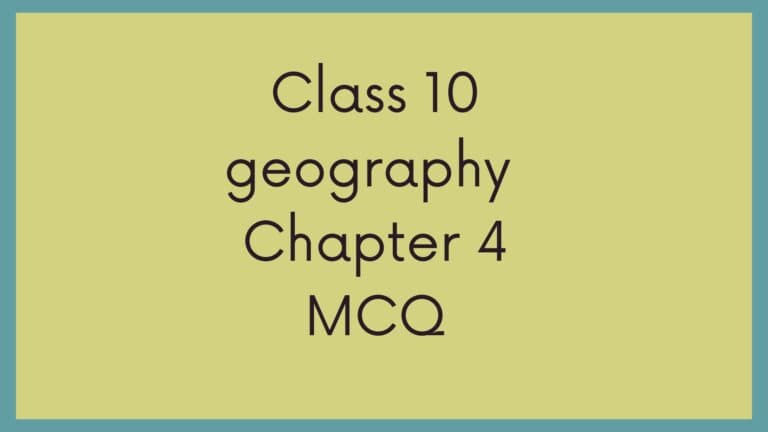Class 12 Geography Chapter 2 MCQ | World Population Important MCQ
This article is determined to provide you with the best Class 12 Geography Chapter 2 MCQ. Use this for your exam preparation and to boost your knowledge. All the questions are based on my Class 12 boards experience of 2025, where I scored 98 out of 100. Check our YouTube for detailed videos. Make sure to complete your preparation before exams.

Top 30 Class 12 Geography Chapter 2 MCQ
Here are Top 30 Class 12 Geography Chapter 2 MCQ:
Q1. Which continent has the highest population?
a) Africa
b) Asia
c) Europe
d) North America
Answer: b) Asia
Q2. Which is the most populated country of the world (2020 data)?
a) India
b) USA
c) China
d) Indonesia
Answer: c) China
Q3. Which country is expected to surpass China in population by 2030?
a) USA
b) Nigeria
c) India
d) Brazil
Answer: c) India
Q4. What proportion of the world’s population lives in Asia?
a) About 60%
b) About 40%
c) About 30%
d) About 20%
Answer: a) About 60%
Q5. Which of the following regions is sparsely populated?
a) Ganga Plains
b) Amazon Basin
c) North China Plain
d) Western Europe
Answer: b) Amazon Basin
Q6. Which river valley is one of the most densely populated in the world?
a) Mississippi
b) Nile
c) Amazon
d) Danube
Answer: b) Nile
Q7. Which country has the highest population density?
a) Bangladesh
b) India
c) Japan
d) Netherlands
Answer: a) Bangladesh
Q8. Which factor is the most responsible for dense population in river valleys?
a) Minerals
b) Fertile soil and water
c) Industries
d) Political stability
Answer: b) Fertile soil and water
Q9. Which of the following is NOT a factor affecting population distribution?
a) Climate
b) Relief
c) Ocean currents
d) Water availability
Answer: c) Ocean currents
Q10. Population density is expressed as:
a) Persons per sq. km
b) Births per thousand persons
c) Deaths per thousand persons
d) Growth per decade
Answer: a) Persons per sq. km
Q11. The world’s average population density is approximately:
a) 51 persons/sq. km
b) 60 persons/sq. km
c) 45 persons/sq. km
d) 30 persons/sq. km
Answer: b) 60 persons/sq. km
Q12. Which type of landform generally attracts high population?
a) Mountains
b) Plains
c) Deserts
d) Polar regions
Answer: b) Plains
Q13. Which of the following is a sparsely populated area?
a) South-East Asia
b) Western Europe
c) Himalayas
d) North-East USA
Answer: c) Himalayas
Q14. Which region of the world has the least population?
a) Antarctica
b) Australia
c) Africa
d) South America
Answer: a) Antarctica
Q15. Which of the following is a push factor of migration?
a) Job opportunities
b) Better education
c) Poverty and unemployment
d) Healthcare facilities
Answer: c) Poverty and unemployment
Q16. Which of the following is a pull factor of migration?
a) War
b) Political instability
c) Better living conditions
d) Natural calamities
Answer: c) Better living conditions
Q17. Which component is NOT included in natural growth of population?
a) Births
b) Deaths
c) In-migration
d) Out-migration
Answer: c) In-migration
Q18. The annual growth rate of world population in 2020 was approximately:
a) 1.0%
b) 1.05%
c) 2.0%
d) 2.5%
Answer: b) 1.05%
Q19. Which region is known for extremely high density due to industrialization?
a) Sahara Desert
b) Ruhr Valley (Germany)
c) Tibet Plateau
d) Siberia
Answer: b) Ruhr Valley (Germany)
Q20. Which stage of Demographic Transition shows high birth and high death rates?
a) Stage I
b) Stage II
c) Stage III
d) None
Answer: a) Stage I
Q21. Which stage of Demographic Transition is India currently passing through?
a) Stage I
b) Stage II
c) Stage III
d) Stage IV
Answer: c) Stage III
Q22. Which stage of Demographic Transition is marked by high birth rate and declining death rate?
a) Stage I
b) Stage II
c) Stage III
d) Stage IV
Answer: b) Stage II
Q23. Which of the following scholars gave the theory of population in 1798?
a) Karl Marx
b) Thomas Malthus
c) Griffith Taylor
d) Vidal de la Blache
Answer: b) Thomas Malthus
Q24. According to Malthus, population grows:
a) Arithmetically
b) Geometrically
c) Exponentially
d) Both b and c
Answer: d) Both b and c (geometrically/exponentially)
Q25. According to Malthus, food supply grows:
a) Arithmetically
b) Geometrically
c) Exponentially
d) None of these
Answer: a) Arithmetically
Q26. Which of the following is NOT a component of population change?
a) Birth
b) Death
c) Migration
d) Literacy
Answer: d) Literacy
Q27. Which of the following regions has low population due to extreme cold?
a) Sahara Desert
b) Amazon Basin
c) Polar regions
d) Deccan Plateau
Answer: c) Polar regions
Q28. The most significant cause of population explosion in the last 100 years has been:
a) Increase in birth rate
b) Decline in death rate
c) Large-scale migration
d) Increase in agriculture
Answer: b) Decline in death rate
Q29. Which of the following countries has negative population growth?
a) Japan
b) Germany
c) India
d) Nigeria
Answer: b) Germany
Q30. Which one is considered a positive check on population growth by Malthus?
a) Family planning
b) Late marriage
c) Famine and epidemics
d) Birth control
Answer: c) Famine and epidemics
Top 10 best Assertion–Reason Questions (ARQs)
Q1.
Assertion (A): 90% of the world’s population lives in 10% of the land area.
Reason (R): Population is evenly distributed across the globe.
- a) Both A and R are true, and R is the correct explanation of A.
- b) Both A and R are true, but R is not the correct explanation of A.
- c) A is true but R is false.
- d) A is false but R is true.
Answer: c) A is true but R is false.
Q2.
Assertion (A): Water availability plays a crucial role in population distribution.
Reason (R): Most densely populated regions are found near river valleys.
Answer: a) Both A and R are true and R is the correct explanation of A.
Q3.
Assertion (A): Population density in plains is higher than in mountains.
Reason (R): Plains provide fertile soil, water, and ease of transport.
Answer: a) Both A and R are true and R is the correct explanation of A.
Q4.
Assertion (A): Sahara Desert is sparsely populated.
Reason (R): It has fertile soil and abundant rainfall.
Answer: c) A is true but R is false.
Q5.
Assertion (A): Migration is an important component of population change.
Reason (R): Migration only decreases the population of origin region, not the destination.
Answer: c) A is true but R is false.
Q6.
Assertion (A): The average density of world population is about 60 persons per sq. km.
Reason (R): Population is equally spread all over the world.
Answer: c) A is true but R is false.
Q7.
Assertion (A): Stage II of Demographic Transition is known for high birth rate and declining death rate.
Reason (R): Better healthcare and sanitation reduce deaths while social norms keep birth rate high.
Answer: a) Both A and R are true and R is the correct explanation of A.
Q8.
Assertion (A): Thomas Malthus argued that population grows geometrically while food grows arithmetically.
Reason (R): He believed population growth will always outpace food supply.
Answer: a) Both A and R are true and R is the correct explanation of A.
Q9.
Assertion (A): Urban areas generally have higher population density.
Reason (R): They provide more employment and better facilities.
Answer: a) Both A and R are true and R is the correct explanation of A.
Q10.
Assertion (A): Death rates have sharply declined in the last century.
Reason (R): Advances in medical facilities and food supply are the main reasons.
Answer: a) Both A and R are true and R is the correct explanation of A.
World Population Statement-Based Questions
Q1. Consider the following statements:
- Asia is the most populated continent.
- Antarctica has almost negligible permanent population.
- Europe has one of the lowest density of population.
Which of the above are correct?
a) 1 and 2 only
b) 2 and 3 only
c) 1 and 3 only
d) 1, 2 and 3
Answer: a) 1 and 2 only
Q2. Identify the correct statements about factors influencing population distribution:
- Fertile soils attract high population.
- Harsh climates discourage settlement.
- Industrialisation leads to dense population.
Answer: All 1, 2, 3 are correct.
Q3. Which of the following are features of Stage I of Demographic Transition?
- High birth rate
- High death rate
- Low population growth
- High literacy and urbanisation
Answer: 1, 2 and 3 only
Q4. Choose the incorrect statements regarding Malthus’ theory:
- Population grows geometrically.
- Food grows arithmetically.
- Population growth always matches food growth.
Answer: Incorrect → Statement 3
Q5. Which of the following are true about migration?
- It is a component of actual population growth.
- Push and pull factors affect migration.
- It changes population size and structure of both origin and destination.
Answer: All 1, 2, 3 are correct.
- NEHU CUET 2025 Statistics Merit List PDF Download
- BHU CUET UG 2025 Merit List PDF download | BHU CUET Cutoff
- Top 5 Commerce Colleges Without CUET 2026
- Class 10 IFM Unit 5 Derivatives Most Imp MCQ | Financial Markets
- Best Commerce Colleges in Mumbai – Complete Guide to Admission, Fees and Placements 2025







2 Comments